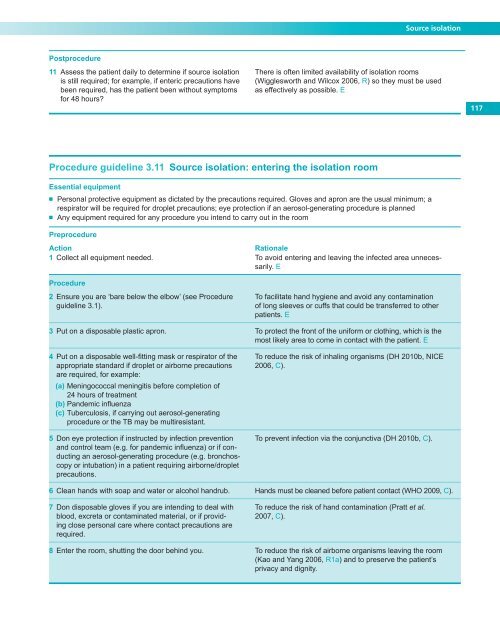Infection prevention and control - Royal Marsden Manual of Clinical ...
Infection prevention and control - Royal Marsden Manual of Clinical ...
Infection prevention and control - Royal Marsden Manual of Clinical ...
Create successful ePaper yourself
Turn your PDF publications into a flip-book with our unique Google optimized e-Paper software.
Postprocedure<br />
11 Assess the patient daily to determine if source isolation<br />
is still required; for example, if enteric precautions have<br />
been required, has the patient been without symptoms<br />
for 48 hours?<br />
Procedure guideline 3.11 Source isolation: entering the isolation room<br />
Essential equipment<br />
■ Personal protective equipment as dictated by the precautions required. Gloves <strong>and</strong> apron are the usual minimum; a<br />
respirator will be required for droplet precautions; eye protection if an aerosol-generating procedure is planned<br />
■ Any equipment required for any procedure you intend to carry out in the room<br />
Preprocedure<br />
Source isolation<br />
Action Rationale<br />
1 Collect all equipment needed. To avoid entering <strong>and</strong> leaving the infected area unnecessarily.<br />
E<br />
Procedure<br />
2 Ensure you are ‘bare below the elbow’ (see Procedure<br />
guideline 3.1 ).<br />
To facilitate h<strong>and</strong> hygiene <strong>and</strong> avoid any contamination<br />
<strong>of</strong> long sleeves or cuffs that could be transferred to other<br />
patients. E<br />
3 Put on a disposable plastic apron. To protect the front <strong>of</strong> the uniform or clothing, which is the<br />
most likely area to come in contact with the patient. E<br />
4 Put on a disposable well-fi tting mask or respirator <strong>of</strong> the<br />
appropriate st<strong>and</strong>ard if droplet or airborne precautions<br />
are required, for example:<br />
(a) Meningococcal meningitis before completion <strong>of</strong><br />
24 hours <strong>of</strong> treatment<br />
(b) P<strong>and</strong>emic infl uenza<br />
(c) Tuberculosis, if carrying out aerosol-generating<br />
procedure or the TB may be multiresistant.<br />
5 Don eye protection if instructed by infection <strong>prevention</strong><br />
<strong>and</strong> <strong>control</strong> team (e.g. for p<strong>and</strong>emic infl uenza) or if conducting<br />
an aerosol-generating procedure (e.g. bronchoscopy<br />
or intubation) in a patient requiring airborne/droplet<br />
precautions.<br />
To reduce the risk <strong>of</strong> inhaling organisms ( DH 2010b , NICE<br />
2006, C ).<br />
To prevent infection via the conjunctiva ( DH 2010b, C ).<br />
6 Clean h<strong>and</strong>s with soap <strong>and</strong> water or alcohol h<strong>and</strong>rub. H<strong>and</strong>s must be cleaned before patient contact ( WHO 2009, C ).<br />
7 Don disposable gloves if you are intending to deal with<br />
blood, excreta or contaminated material, or if providing<br />
close personal care where contact precautions are<br />
required.<br />
There is <strong>of</strong>ten limited availability <strong>of</strong> isolation rooms<br />
( Wigglesworth <strong>and</strong> Wilcox 2006 , R) so they must be used<br />
as effectively as possible. E<br />
To reduce the risk <strong>of</strong> h<strong>and</strong> contamination ( Pratt et al.<br />
2007, C ).<br />
8 Enter the room, shutting the door behind you. To reduce the risk <strong>of</strong> airborne organisms leaving the room<br />
( Kao <strong>and</strong> Yang 2006 , R1a) <strong>and</strong> to preserve the patient’s<br />
privacy <strong>and</strong> dignity.<br />
117


